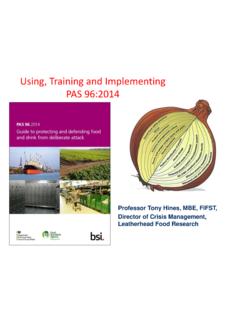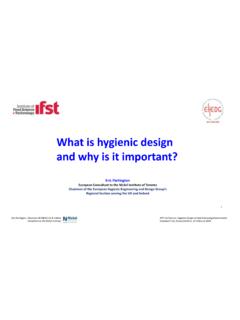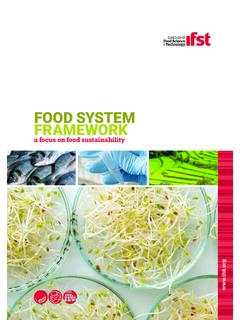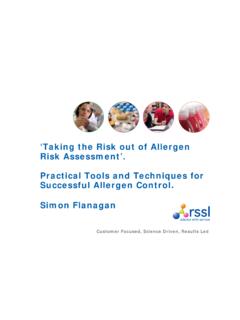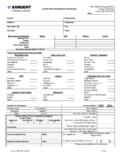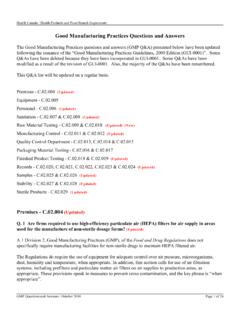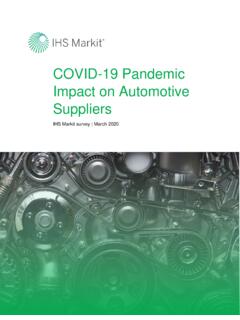Transcription of 1.6.4 Raw Material Risk Assessment
1 Raw Material Risk Assessment Raw Material Risk Assessment 22/06/2018 SALSA 2018 Why? It is a legal requirement that the food you sell is fit to consume and is not misleadingly labelled. Raw materials can be a source of contamination or may not be what they claim to be, if purchased from unknown or irregular suppliers. You must have adequate precautions in place to prevent this happening. Carrying out a supply chain Risk Assessment of your sources can help you do this. What do I need to do? Start with a review of all your food raw materials and their suppliers. o What information do you hold for each raw Material ? (see ). Specs should include test details relating to illegal additives, pesticides, colourings & antibiotics etc o Do you know the country of origin and who manufactures/processes your Material ?
2 O Check your Supplier Approval process (see ). Adulteration ie reducing the quality of food by including a foreign substance, in order to lower costs or fake a higher quality and Substitution ie replacing a food or ingredient with another substance that is similar but inferior can, in theory, occur in any Material but some materials are more at risk than others. The type of evidence you need will depend on the size and complexity of your business. o A micro business (EU definition, <10 employees) should focus on supplier approval. Using reputable/reliable suppliers will reduce, but not remove, the risk of adulteration or substitution. Tools Your list of all raw materials including water and food contact packaging and their suppliers Your Supplier Approval process and Supplier questionnaires Detailed raw Material and packaging specifications Risk Assessment templates Consider using the services of a SALSA Mentor if you are unsure.
3 Tips Don t worry too much about the format of your risk Assessment but do record it Reliable suppliers should be able to provide certificates of analysis for materials with known hazards, so these should always be requested Check current raw Material prices: is it too cheap to be true? Assess whether your existing control measures support prevention of substitution and/or adulteration in your raw materials Keep up to date. Use online alerts systems, trade associations and the internet to regularly check and monitor what, if any, types of adulteration or substitution are occurring As a generalisation, the longer the supply chain, the more opportunity for issues to arise SALSA Requirement: The business shall perform a risk Assessment on all food raw materials, including food contact packaging, in relation to adulteration or substitution.
4 The findings shall be documented and appropriate controls and procedures implemented. Raw Material Risk Assessment Raw Material Risk Assessment 22/06/2018 SALSA 2018 o Small businesses will need to research problems relating to the raw materials they use (eg spices adulterated with Sudan Red Dyes or powdered nuts/shell, substitution with horsemeat in beef, dyes in palm oil). Consider the potential likelihood of adulteration and/or substitution for each raw Material or group of raw materials in your products and assess the risk or significance, just as you would for a HACCP risk Assessment . There is no single method for documenting and determining significant hazards and some businesses will simply make a judgement ie whether a specific hazard is significant or not.
5 However, many businesses prefer a more structured way of deciding. See the example matrix below that could be used to assess the significance of hazards. Having identified the risks relating to your raw materials, you need to decide how you are going to control them. You may be able to use existing control measures (eg goods-in tests etc) and only implement new procedures or checks where considered necessary. Concentrate on your supply chain and goods-in checks ie: o Supplier assurance and supplier approval process (certification/accreditation documents, supplier questionnaires, supplier visits, manufacturer s details) o Request relevant testing certificates from your suppliers (ie Sudan Dyes for chilli powder, nuts/allergens for cumin and paprika) o Make your supply chain as short as possible (buy from manufacturers/direct processors) o Implement additional goods-in checks (eg seals checks, packaging checks - or a Material delivered with a different format packaging than usual may need investigation) o Consider doing some external testing on receipt of raw materials.
6 O Regularly review your suppliers and raw Material specifications (see ). When new materials information is received from a supplier, don t forget to review your risk Assessment and document the dates and reasons for the review. This could be triggered by a non-compliance, such as adulteration or substitution in raw materials delivered and/or a news alert on substitution or adulteration of a raw Material you use on site. Make someone responsible for implementing and maintaining the risk Assessment and train staff who will be involved in monitoring and controlling your system. Example This is an example of a matrix that could be used to assess the significance of the hazards.
7 You could also use a simpler 3 x 3 scoring system. The key point is to identify which hazards are of more significance than others so you can more effectively direct your resources. Scoring system: Likelihood Severity 1 Never happened 1 2 3 4 5 2 Unlikely to happen Likelihood 1 1 2 3 4 5 3 May happen 2 2 4 6 8 10 4 Likely to happen 3 3 6 9 12 15 5 Happening now/Happens regularly 4 4 8 12 16 20 Severity 5 5 10 15 20 25 1 No harm possible 2 No health impact 3 Minor illness or injury 4 Significant illness or injury 5 Death or serious illness Raw Material Risk Assessment Raw Material Risk Assessment 22/06/2018 SALSA 2018 Example of a completed Risk Assessment You should also document your Risk Assessment and any reviews.
8 The example below shows a suitable record. Record the scoring detail, assuming the listed control measures are in place as they will reduce the possibility of this hazard affecting product. You can then see if there is still a need for additional control measures to be put in place. You can see from the example that the risk is still quite high you could ask your supplier to test more often or perhaps test the Material yourself once a year. Raw Material Risk Assessment Scope: Adulteration and substitution risk Assessment for raw Material and food contact packaging used on site Raw Material /Packaging (supplier) Adulteration (details) Substitution (details) likelihood severity Score Control Measures in place Red Chilli powder Sudan Dyes used to raise raw Material value n/a 4 4 16 Certificate of Analysis from supplier.
9 Sudan Dyes testing once a year. Issue: 1 Issue date: 24/11/17 Issued by: AT Doc Ref: a Raw Material Risk Assessment Review Assessment review - reason Date Changes Sudan Dyes detected in Red Chilli supplied (FSA alert from 22/11/17) 23/11/17 Additional control measures implemented more testing Issue: 1 Issue date: 24/11/17 Issued by: AT Doc Ref: b Need more help? See Tools & Tips: Supplier Approval, Specifications, Incoming Goods Checks Documents and publications which provide free guidance on how to protect your business from adulteration and substitution are also available.
10 This is not a comprehensive list. o o o o o o Online alert systems providing access to food incidents which may be relevant to your business: o FSA Sign up to Food Alerts: o RASFF (EU Food and Feed Safety Alerts).

